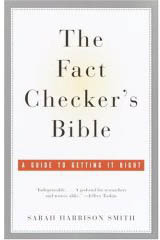 |
One thing I didn’t hear anyone mention at this year’s Nieman conference was the “New Journalism” – that movement pioneered in the mid-1960s by Tom Wolfe, Truman Capote, Gay Talese, Jimmy Breslin. Perhaps because there seems to be a growing sense that at least some narrative nonfiction writers have gone too far in plucking techniques from novelists and applying them to journalism.
What drove this home for me was one of the books I bought from the Harvard Book Store to read on the airplane. It was The Fact Checker’s Bible: A Guide to Getting It Right, by Sarah Harrison Smith, who worked as a fact-checker at The New Yorker and The New York Times Magazine. Ms. Smith argues that the fabrications of Jayson Blair of The New York Times, Stephen Glass of The New Republic, and, stretching even further back, Janet Cooke, who won a Pulitzer Prize for her fictionalized story about an eight-year-old heroin addict which ran in the Washington Post.
“One could argue that the New Journalists’ looseness with facts changed reporting standards for some writers, making fabrication seem both more acceptable and more necessary,” Ms. Smith wrote in her book, which was first published in 2004. “Traditional reporting began to look dull when compared with the excitement offered by “fictionalized” nonfiction.”
Many of the best nonfiction writers today are indebted to the work of those pioneers. Like them, they are using novelistic techniques such as telling their stories in scenes, with closely reported detail and often careful reconstruction through reporting of what their characters were thinking at the time.
Yet the best of today’s bunch, in my view, are sticking strictly to the facts. They’re not imagining what a character might have been thinking or feeling, as Truman Capote did in his nonfiction novel, In Cold Blood. Like a novelist, Adam Hochschild also writes in scenes, with dialogue and richly detailed settings. He, too, constructs his scenes cinematically, as if the reader is experiencing them in five dimensions – thought sight, sound, taste, smell, and touch.
But, unlike In Cold Blood, the book he’s writing now will have around 1,100 endnotes, which are there, he says, so his readers “realize I didn’t make anything up.”
 Samantha says
Samantha says
March 2, 2012 at 11:19 amWell, I am not a fan of fiction materials. I just read them out of curiosity sometimes. Yeah, some of them are great but not to the extent that I count myself as part of it. Anyway, we all have different likes and preferences. That what made us unique from others. So this just deserves some respect. Thank you anyway for sharing.
Samantha
Blog: Porte manteau enfant